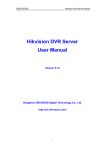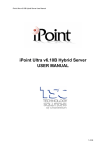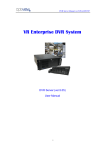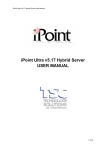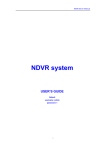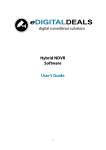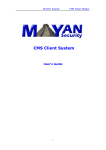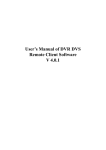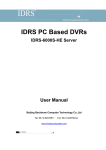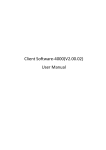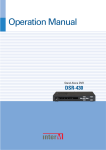Download NetVision DVR system
Transcript
DVR Server Manual ver.6.05/rel.120909 VR Enterprise DVR System DVR Server (ver. 6.05) User Manual I DVR Server Manual ver.6.05/rel.120909 II DVR Server Manual ver.6.05/rel.120909 Contents Chapter1 Start up and Main Interface···························· 3 1.1 Installing ····················································································· 3 1.2 Disk management ······································································· 3 1.3 Start up ······················································································· 5 1.4 Main Interface ············································································ 6 1.4.1 Show tips ····························································································6 1.4.2 Screen menu ·······················································································6 1.4.3 Interface description ········································································10 1.4.4 System Menu ····················································································13 1.4.5 Network panel ··················································································22 1.4.6 PTZ Control panel ···········································································22 1.4.7 Color and Audio adjustment ····························································27 1.4.8 Matrix & display ··············································································27 1.4.9 DI/DO Control ·················································································28 Chapter2 Local setup ···················································· 30 2.1 System setup ············································································· 31 2.1.1 System setup ·····················································································31 2.1.2 Network setup···················································································33 2.1.3 Boot setup·························································································35 III DVR Server Manual ver.6.05/rel.120909 2.2 Camera setup ············································································ 35 2.2.1 Camera setup ···················································································35 2.2.2 Group setup ······················································································39 2.3 Sensor setup ·············································································· 41 2.3.1 Sensor setup ·····················································································41 2.3.2 Group setup ······················································································41 2.4 PTZ & Linkage setup································································ 43 2.4.1 PTZ protocol setup ···········································································43 2.4.2 Motion detection relay & remote client alert ··································44 2.5 E-mail setup ·············································································· 45 2.5.1 SMTP setup ······················································································46 2.5.2 E-Mail setup ·····················································································46 2.6 Digital matrix setup ·································································· 47 2.6.1 Matrix setup ·····················································································47 2.6.2 Display setup····················································································48 2.7 User setup ················································································· 49 2.7.1 User information ··············································································49 2.7.2 User right setup ···············································································50 Chapter3 IP Camera Setup ··········································· 52 3.1 Functional buttons ···································································· 52 IV DVR Server Manual ver.6.05/rel.120909 3.2 Server setup ·············································································· 53 3.3 Channel setup ··········································································· 54 3.4 PTZ control··············································································· 56 3.5 Sensor setup ·············································································· 59 3.6 Alarm setup··············································································· 60 Chapter4 Local playback ·············································· 62 4.1 Main interface ··········································································· 62 4.2 Select playback channel ···························································· 63 4.2.1 Select date ························································································63 4.2.2 Select camera ···················································································63 4.2.3 Select file ··························································································64 4.3 Play file and related operations ················································· 65 4.4 Capture picture ········································································· 66 4.5 Create clip file ·········································································· 67 4.5.1 Create file clip ··················································································67 4.5.2 Backup by time: ···············································································68 4.5.3 View Backup file ···············································································71 4.6 Search captured picture ····························································· 73 4.7 Fast search ················································································ 74 V DVR Server Manual ver.6.05/rel.120909 4.8 Camera status············································································ 75 4.9 Show files ················································································· 76 Chapter5 IE client ···························································· 78 5.1 Functions of IE Client ······························································· 78 5.2 Main interface ··········································································· 78 5.2.1 Connection operations ·····································································79 5.2.2 Connection/Record status ································································79 5.2.3 Partition mode ·················································································79 5.2.4 PTZ Control ·····················································································80 5.2.5 Quit program····················································································80 5.3 Local search ·············································································· 80 5.4 Remote search ·········································································· 81 5.4.1 Fast download record data ······························································82 Chapter6 Mobile Client ················································· 84 6.2 Download software ··································································· 84 6.3 Install and connect ···································································· 85 6.3.1 Installation ·······················································································85 6.3.2 Connection ·······················································································85 6.4 Login Interface ········································································· 85 VI DVR Server Manual ver.6.05/rel.120909 6.5 Camera List ·············································································· 86 6.6 PTZ control··············································································· 87 Chapter7 Appendixes ··················································· 88 7.1 Appendix A: Fast key reference ················································ 88 7.2 Appendix B: Audio preview······················································ 89 7.3 Appendix C: Update drivers of compressed card ······················ 90 7.4 Appendix D: How to use “Copy File” folder. ··························· 92 Refer to the Tutorial video for other selected topic illustrated in video format. The tutorials are small video file that can be played from the local DVR system. It will illustrate many of the common task involved in working with your DVR system. Please follow the link from the desktop “Click here for Technical Support and Serial number”. VII DVR Server Manual ver.6.05/rel.120909 Introduction and Overview: Thank you for purchasing the VR Enterprise DVR system. This user manual is designed to introduce you the system and explain each function of DVR system for you to set up the system to use effectively, stably, and professionally to meet your security recording needs. Note: Please set the resolution of the display monitor to 1024*768 pixels before using this system. IMPORTANT! Operators should go through this manual thoroughly before installing/utilizing the DVR system. Cost Efficient – Uses IP infrastructure. There is no need for costly dedicated cables between sites and servers to efficiently manage data, video, audio, and other files. The DVR software uses H.264 technology which maximizes the use of the space on your HDD. Leverage - Centralized control of setup parameters, scheduled alerts and maintenance of those individual digital image devices like DVR, VR, etc. Straightforward Application and Management - Supports centralized network recording management, flexible storage and HDD coverage and usage. Password-protected application with multi-level user rights assignment per user. System features: -Hardware support for H.264 compression, therefore giving you low HDD cost and excellent video quality -Web access through LAN or WAN -Real time full-motion video-capture & display (Up to 64 channel video input) -Real time high-speed recording: Up to 30 fps per channel -Synchronous audio recording (optional) -Motion detection (Whole area or up to 12 detection zones per channel) -Normal recording (continuous) and event recording (Motion detection or external sensor) -Electron Map pop-up when an alarm occurs -System operating and alarm logging -Alarm-before recording -Remote recording -Sending alarm messages automatically -Sending alarm image to email box as attachment automatically -Matrix display and group display -Duplex mode (Recording while playback) -Network support (Remote access via LAN, Ethernet, PSTN, ISDN, ADSL) -Pan, tilt, zoom, focus & speed dome control from within the software -Search/playback by date/time directory (random-access) and via Smart Search -Backup & burn CD directly -Remote talking between server and client or server and server 1 DVR Server Manual ver.6.05/rel.120909 2 DVR Server Manual ver.6.05/rel.120909 Chapter1 Start up and Main Interface 1.1 Installing 1) Before you run DVR server, please check all connectors are firmly connected. 2) By default, the operating system will identify the compressed cards automatically as the new hardware. First, you should install the compressed card and its driver: Appendix C: Update drivers of compressed card Error! Bookmark not defined. 1.2 Disk management When you installed the software, you will see this interface: Notice: If you don’t create the file management system at first, the Dvr server will not record. Disk Drives: Display the disk and its format. Total Size (M):Display the disk total size. Free Space (M): Display the free space of the disk. Allotted Data Package: Display the number of the allotted data package. Residual 3 DVR Server Manual ver.6.05/rel.120909 Data Package: Display the residual data package. New Data Package: Select the number of the new data package. You can select the number of the new data package in the drop-down list. The software could calculate the rest space automatically. Notice: the space of the package is 256M as the default, you cannot be changed. The Disk Manage utility calculates the space of the new data package and 4 DVR Server Manual ver.6.05/rel.120909 allows three free packages as default; however it is recommended that at least 40 packages are left free. Click the to create the data and index file system. Note: You can’t delete some files of the _RECORD_DATA_ file folder if the space is not enough, you should delete the whole _RECORD_DATA_ file folder and run the disk manage utility again. 1.3 Start up Left-Double-Click shortcut icon to start the server software. The main interface is as follows: Note: When you run the system for the first time and you do not have a valid registration key for the cards, the system will pop up a dialog box to show that you will be working in test mode until a valid key is installed. After you confirm it, the system will work in test mode normally. 5 DVR Server Manual ver.6.05/rel.120909 1.4 Main Interface 1.4.1 Show tips 1. When the mouse moves closely or stops above a button, a text tip will be shown to interpret the function of it immediately. 2. Zoom in/out video image: Left-Double-Click a camera window to zoom in/out of the video image (or press F11 on the keyboard). 3. System will detect cards and read the total number automatically, and the corresponding number buttons will be displayed dynamically. 4. Recording status: a. This icon means the system is recording normally. b. This icon means the system is recording manually. c. This icon means the system is recording in motion detection. d. This icon means the system is recording in sensor detection. 1.4.2 Screen menu Press the TAB key or Page UP (select next camera window) and Page Down (select previous camera window) key on keyboard to select one live camera window. 1. Full screen Single-Right- Click image area, it will popup a menu, then select “full screen” to change display mode to full screen (or press F12 on the keyboard). When you want to resume origin mode, you should Single-Right- Click image area and select “Restore display”. 2. Instant playback Single-Right-Click desired camera window and select “Instant playback” (except IP Camera, it can just play back instantly in the window that is not used). After that, choose a time from the submenu, and then system will play back video data of current camera in current window according to your selection (E.g.: you select 1min, system will play back previous 1 minute video data of current camera in current window). Also, you can play back video data of one current live camera in a window that is not used by any cameras (always black background with no “Video Loss” information, IP 6 DVR Server Manual ver.6.05/rel.120909 Camera can only play back instantly in those windows): Select a window, and then Single-Right-Click it to select “Instant playback”. Finally, choose a time and the camera you want to playback, and then system will play back video data in current window according to your selection. The window that is playing back video data will indicate a yellow border to be different from the live windows. In the course of the instant playback, you can press the Space bar to switch the play/pause status or direction key → and ← to play next and previous frame. If you want to stop the instant playback, you can Single-Right-Click the play backing window, and select “End playback”. 3. Alarm popup Single-Right-Click video image area in main interface and select “Start alarm popup” after you set “Alarm camera popup interval” in system setup, otherwise, it can’t be selected. After that when there is a motion detection alarm (set in PTZ & Linkage setup and Motion detection setup) or an alarm is triggered by sensor (set in Sensor setup), system will display alarm cameras in sequence. This function does not include IP cameras, even though an IP camera can have alarms, their images will not pop up. When you want to end 7 DVR Server Manual ver.6.05/rel.120909 this function, you can Single-Right-Click video image area and select “Pause alarm popup”. 4. OSD Adjustment Single-Right-Click video image area in main interface and select “OSD Adjustment” to adjust the position of items on the OSD (IP Camera does not have this function; you can set the OSD position in an IP Camera remotely). 8 DVR Server Manual ver.6.05/rel.120909 OSD includes time and channel name. In this screen you can press time or channel name and drag them to where you want directly, after that you can press button to save and press button to resume time and channel name to default position. 5. IP Camera setup For this function, it is only available when you Right-single-Click image of IP camera. It will describe in details in IP Camera Setup. 9 DVR Server Manual ver.6.05/rel.120909 1.4.3 Interface description 1. Partition mode Press button to set the partition mode of the main screen. There are many partition levels; the default partition is determined by the total number of channels on the local card, you can select the suitable partition according to the number of video inputs. 2. Videos-play-in-sequence mode switch Press button to switch between viewing all cameras in current window partition to begin sequencing dynamically between the remaining camera windows, but not when the current partition number is equal to the total channels of the card. 3. Emergency recording button Press button to trigger recording of all cameras for 30 seconds even if they have been set to record by any other modes. This function is useful to deal with emergency where quick response is required. 10 DVR Server Manual ver.6.05/rel.120909 4. Image capture Press button to save a still image of selected camera to local hard disk for reviewing or print. 5. Manual record switch Press button to record manually and press it again to stop manual recording for selected camera. 6. Information display panel From the information display panel you can see the current day of the week, the date, time, CPU percentage being used, the amount of HDD space with recorded data, and currently selected camera. When the capacity of HDD is not enough or there are read/write errors while recording, the system will pop up information to inform of the failure of recording and the corresponding camera will stop recording. 7. Local setup submenu Press button to enter Local setup submenu. 8. Local playback submenu Press button to enter Local playback submenu to search local video/audio data. 11 DVR Server Manual ver.6.05/rel.120909 9. System lock Press button to prevent unauthorized users to operate the DVR system. Press this button again; the unlock dialog box will be displayed. Input your User ID and password then press OK to unlock it. Default User ID is “admin”, no password. Note: If the DVR system is not configured as User Manage Mode, the lock button will be unusable and allow anyone to access it (even in client program, user name and password will be useless) 10. Minimize button Press keyboard). button to minimize the main window (or press WIN + Z on 11. Exit program Press button to exit program. After clicking this button, a dialog will display. DVR system. 12 Click “OK” to close the DVR Server Manual ver.6.05/rel.120909 1.4.4 System Menu 1. IP Camera Device List Press this bar to add IP Modules to DVR system. 13 DVR Server Manual ver.6.05/rel.120909 (1) Add IP camera device Press button to add an IP Camera device: Figure2— 1 【Server Name】Set a name for the new IP camera device. 【IP Address】Input the address of the IP Camera, it is an IP address or IP alias of an IP camera which is connected through DNS Server. 【Steam Type】Select the main stream or sub stream for the device. 【Connect Port】Port that the system will connect to the IP Camera. 【Login user ID/Login Pass】When the user want to visit IP Camera and the server has used the function of rights management, login user ID and password will be checked. If the user has no right to visit that camera, the connection will be cut down automatically. 【If use DNS to get IP】Select whether use DNS to get IP or not, if the server end is the dynamic IP address, users need use DNS to get the server’s IP. 【DNS Server IP】Set IP address of DNS server host. 【DNS Server Port】DNS server host’s port, which is provide to connect DNS software. 14 DVR Server Manual ver.6.05/rel.120909 (2) Modify IP camera Press button to modify IP camera’s information. The interface is the same as the Add IP Camera interface. (3) Delete IP camera device Click on the IP device that you which to delete and press the button to delete a connected server. When the system is in processing to add an IP camera device (“connecting…” indicated in connect status column), user can not delete that IP camera device and must wait until “connect fail” is displayed. (4) Decode card work mode DVR system supports playing video of IP Camera to a TV directly. It uses the hard decoding function of decoder, so you should set the work mode of decoder. If you don’t use hard decoding, you can’t output video of IP Camera real-time, user can only play back recording data to TV monitor by selecting Playback to TV Wall function. Note: Each 4002MD card can decode 2 channels D1 or 4channels CIF. Each 4004MD card can decode 4 channels D1 or 8 channels CIF. When you select the work mode, system will send out corresponding channels of IP cameras from the first IP camera. It will not influence soft decoding for cameras of local board cards. 2. Backup System Parameters Select this function to export system configurations. 3. Import System Parameters Select this function to import system configurations. 15 DVR Server Manual ver.6.05/rel.120909 4. Burn backup data CD Select this function to burn video data to CD/DVD. It is the same function as burning a CD/DVD in Local Playback. 5. Remote chat Select this function to connect a remote Client or Server for a live chat via IP address, but first, you should be sure you have installed an audio card and microphone in each PC. 6. Write working log This is useful to record events that occur during the operator’s shift. 7. View System log Select this function to view all actions of recording as well as operations. System log keeps a record of system events such as program startup and shutdown, changing camera setup and all operator or system daily activities according to time and date. Users can view system log by date. System parameters include operations, system prompts, alarms and other activities. 16 DVR Server Manual ver.6.05/rel.120909 8. Open Explorer When keyboard is locked, Users can operate window resource via explorer. 9. Open electron map Select this function to set E-map, Click icon and then Right-Single-Click on the map, the setting picture will appear. You can add or delete sensors and cameras that pointed by the arrow or change the digital map. 17 DVR Server Manual ver.6.05/rel.120909 If it is set to appear automatically, when the sensor is triggered, the map will appear automatically and the sensor being triggered will be marked. For triggered camera, user can Left-Double-Click it to view video. 10. Open Screen Keyboard This function allows a user to use soft keyboard, you can press this bar to open the screen keyboard. In the setup interface you can Left-Double-Click a modifiable text based option to open this keyboard. The keyboard can be closed manually. 11. Play back to TV monitor In DVR system, the recording data can be transmitted to TV monitor via Matrix card. 18 DVR Server Manual ver.6.05/rel.120909 When system runs “Playback to TV Wall” process, the Matrix card will output recording data. If this process does not run, matrix decode card will output real-time video according to your matrix board setup. Otherwise, when you use matrix card to decode video data from an IP Camera, you can’t use this function to play back recording video data to TV Monitor but only output real-time video of local board and IP Camera to TV Wall according to your setting in Matrix setup. In this process, you can play back record file by date and camera, and the record file will be played automatically. 12. Motion detect setup By default, the entire screen is set as motion detection area which is indicated with a green border around the entire image. To mask a specific area, you can click the button to cancel the full screen detection border; then Left-Single-Click and drag/draw around the desired area. A green rectangle will mark the area. Also, you can set any other areas. Any activity in the motion detection areas will trigger recording, depending on the reaction mode; and alarms may be generated along with electronic map icons flashing in alert mode. Click button to test the sensitivity of motion detection. The sensitivity can be adjusted by dragging the slider bar below the motion detection window. Notice: motion sensitivity value will affect the accuracy of smart search 19 DVR Server Manual ver.6.05/rel.120909 1.Add mask/Delete mask Press button to set the area to be shielded. If there are some areas that you don’t want to show, you can mask those areas with the mouse until they change to black. You can set several covered areas. Press this button again to finish adding Press button to delete all covered areas. 13. DVR board work mode setup Each DVR system supports maximum 8 PCs 400XHC (total channel is equal to 64) series board, so user can set its work mode via this GUI. 20 DVR Server Manual ver.6.05/rel.120909 For 4004HC, 4008HC, 4016HC series board model, you can set its work mode. The new DVR board work mode will take effect after rebooting DVR Server software. 14. Keyboard shortcuts setup If you don’t want to use certain shortcut keys, you can disable the shortcut functions and save the setup. 21 DVR Server Manual ver.6.05/rel.120909 1.4.5 Network panel This panel displays the network configuration of DVR system. Information of network adapter IP address of the system Subnet Mask Net Gate When client is linked, its IP address will be displayed in this window (the current IP only). Press the right mouse button to disconnect the client. 1.4.6 PTZ Control panel In the DVR system, there are three ways to operate PTZ cameras; a. Panel operate; b. Operate in video area directly ; c. Keyboard operate 22 DVR Server Manual ver.6.05/rel.120909 1. Relay (On/Off) Control the PTZ cameras internal relay (relay1) or the decoder’s relay (relay 1). Used to turn on a light or control an access gate. 2. Wiper (On/Off) If using the PTZ cameras corresponding wiper control relay, this toggles the relay/wiper on and off. 3. Zoom + / Zoom – Controls the zoom function of the PTZ camera. 4. Focus + / Focus – Overrides the auto-focus setup of the PTZ camera, adjust the focus of the image. 5. Iris + / Iris – Overrides the PTZ cameras auto-iris and brightens or darkens the image. Pressing this button initiates the connected PTZ camera to do an automatic tour of 360°, but for speed dome, many PTZ factory defaults forbid this command. By pressing and holding these buttons, the PTZ camera will move up, down, right and left as well as other directions. 6. Speed Press and drag the slider bar to adjust the speed of PTZ. 23 DVR Server Manual ver.6.05/rel.120909 7. Auto tracking (On/Off) Press button to use the PTZ camera tracking the floating object automatically. 8. Speed Dome Press button to operate the speed dome, including Preset Setup, Preset Call and Preset Tour: (1) Preset Setup In this screen you can set the preset position: 24 DVR Server Manual ver.6.05/rel.120909 Add/Delete preset In this section you can set the preset name with its sequence number, / button to add/delete a preset, when you want to then you can press modify the preset you can press button to confirm your modification. For different cameras, they have different commands to open and set, so you can choose the call mode in the drop-list for different cameras. Home position You can set a home position for the PTZ. When there have no PTZ actions after the setting time system will call the PTZ to the home position. Tour preset In this section you can set the tour schedule. First you can choose a / button group, and then set the track for this schedule; you can press to add/delete a preset to it. After you choose the preset name you can set the time to keep on. (2) Preset call When you select this function, system will show all the preset names you set in Preset Setup menu; you can click one to move to it. (3) Preset Tour When you selectq this function, system will show the entire tour groups you set in Preset Setup menu; you can click one to execute it. 25 DVR Server Manual ver.6.05/rel.120909 9. Control PTZ via video window On the Image 3, each rectangle area is the effective area of every action. Arrow denotes the direction of the action. Pressing and dragging the mouse to the corresponding area can control the PTZ. 26 DVR Server Manual ver.6.05/rel.120909 1.4.7 Color and Audio adjustment ↑Increase ↓Decrease ① ② ③ ④ ⑤ ①Press the first button and drag to adjust the brightness of the image that you selected, and you can resume its default value by pressing . ②Press the second button and drag it to adjust the contrast of the image . that you selected and you can resume its default value by pressing ③Press the third button and drag it to adjust the hue of the image that you selected, and you can resume its default value by pressing . ④Press the fourth button and drag it to adjust the saturation of the image that you selected, and you can resume its default value by pressing . ⑤Press the fifth button to switch sound of the audio that related to the image you selected and drag the bar to adjust the volume, and you can resume its default value by pressing . 1.4.8 Matrix & display This panel includes matrix group and display group. Each group includes 16 numeric buttons; each button denotes one type of matrix or display. This will describe in System setup. 27 DVR Server Manual ver.6.05/rel.120909 1.4.9 DI/DO Control 1. DI control Press a number button to check sensors all of the time forcibly even if a user didn’t setup check sensor in sensor setup. The channel of DI and DO is determined by the setup of DI/DO device you set in System setup. The status of DI has three types: Input channel 1 doesn’t check sensor forcibly. Input channel 1 checks sensor forcibly. Input channel 2 has an alarm inputting When there has no alarm yet, user can press number button to check sensor forcibly. Press the button again to stop to check all time, then system check sensor according to Sensor setup. When there has an alarm, the corresponding button will show the alarm with green. Note: When you select 7632 and the combination is not the standard configuration (combination of 7608 and 7616 or 7608: total DI is less than 32), some ports are not available according to the setting of decoder address. For example: user selects 7632 and the combination is 7608 (decoder address is 1) and 7616 (decoder address is 2), then the DI port 9 to 16 is not available, the status indication is not available. 28 DVR Server Manual ver.6.05/rel.120909 2. DO control Press number to open/close alarm device relay switch manually. The status of DO has two types: Output channel 1 is close. Output channel 2 is open. When there are no alarms triggered out, a user can press the number button to output an alarm forcibly and the button will show it in green, press it again the output will be closed. 29 DVR Server Manual ver.6.05/rel.120909 Chapter2 Local setup The DVR System Configuration and Setup include 7 types configuration setup: System setup Camera setup Sensor setup PTZ & linkage setup Email setup Matrix & display setup User setup 30 DVR Server Manual ver.6.05/rel.120909 2.1 System setup 2.1.1 System setup 【Camera Channel】Displays total channels of local board card, the number of IP Cameras is not included. IP Camera are set remotely in IP Camera setup. 【Sensor Input】 Display number of sensors (DI). 【Sensor output】Display the number of alarms(DO). 【Audio Monitor】Select real-time monitoring audio. 【Use E-Map】Select to use the Electron Map. 【splitter auto interval】Set auto-split changing interval time. 【DI/DO Port】Select sensor/alarm driver connecting port, it must be different from PTZ Port. If you do not use alarm input, you can close this function. To avoid conflicts to the PTZ port, you should set and use different ports for these two functions. 【System Keystroke】System keystroke. When it is enabled, functions of system keys will be disabled (i.e. Ctrl+Alt+Del). 31 DVR Server Manual ver.6.05/rel.120909 ***NOTE: When【System Keystroke】is enabled it alters the Windows system file “newgina.dll” in such a way that it may cause any antivirus software installed on the DVR system to trigger that it has detected the “newgina.dll or nthack trojan” virus. If possible please make an exception for this file in your antivirus software or ignore these specific warnings. 【Save Log for/Days】Log save days(max 100 days). 【Save Mode】Select record mode when there is not enough HDD space free. If “Overwrite data” is selected, the DVR system will delete the recorded data of the oldest day automatically to free HDD space for new recordings. If “Stop recording” is selected the DVR system will stop recording and give a warning message (Notice: each disk will reserve 1000M of space). 【Record Begin Disk】Select the first disk from which the DVR system saves data. The previous disks of this one will not be used to record and it will not be checked by the system. When there is not enough free space on the HDD or there have been any errors while recording, the system will display a failure to record message and the corresponding camera will stop recording. 【Alarm camera popup interval】Set the interval of alarm camera, if you select ”—“, you can’t select function ”Start alarm popup”. 【DI/DO Device】Select receive alarm device type. When you change the type of alarm device, you should reboot the system to update the device information in DI/DO control panel. Note: Currently, system support following serials DI/DO devices: 7608, 7609, 7616, 7616B, 7632 and 7632B. 7632 includes two 7616 (or combination of 7608 and 7616), and 7632B includes two 7616B. When you select these two options you must set their decoder address as 1 and 2, and they should connect with PC through RS 485 converter after they connect parallel with each other. 【Date Mode】Select the way to display date. It decides the date display mode of DVR system, including the information panel on the main screen, the date panel of the playback window and OSD date in video. 【Alarm Beep】Select disable or enable from drop-down list. If “enable” is selected, when there is an alarm, system will make beeping noise. 【Time Mode】 Select time format from the drop-list. After you change the format it will affect the OSD format, information in information display panel and file lists. 【Default Camera type】Set the default mode of video from PAL and NTSC, it is available when the input video is lost and for the decoder to playback local video to TV Wall. 【Default Grab save path】Select the save path to the grab (snapshots). 32 DVR Server Manual ver.6.05/rel.120909 2.1.2 Network setup 【Remote Connection】Used for network connections. If set to “disable”, it will not permit any clients to connect to this DVR system. 【Remote Disp Use Port】Select remote connection port for Clients. 【Net Send Priority】 There are three items for selection. “Smooth” requires that the receiving system has a large buffer. Setting this option to “Real Time"requires that the receiving system has enough bandwidth, otherwise, the data will appear off and on when it is sent from the network. 【PDA Connection】Select whether to allow PDA connections to the DVR system or select “disable” to prevent the connection of any PDA devices. Note: To use PDA connection normally, the board card should support dual compression and user must set dual setting in local setup (can’t set remote image same as recording). 【PDA Connect Port】Select remote connection port for PDA devices. 【Alarm Auto Connect】Assign a network client to receive alarm messages when there is an alarm. The alarm channel image will automatically display in the client software, but users must be sure that clients are running on that IP address. *Note: Alarm auto connection to an IP is used to input alarm automatically. When the sensor is set to normal or motion record and there is IP address setup, the system will check if the client has connected with this system. If there is no connection, the system will try to connect with it through Port 5300 (preset). If it cannot connect, the system will keep trying until the connection is OK. Please ensure that your client’s program is in use, that Port 5300 is listening and the network is in good condition. If it is not, the system will not be stable. 【Alarm Send Port】 This is the alarm message connecting port, which is used to send an alarm from the DVR Server to a Client. 【Web Server Port】The IE client connecting port. Default value is 80 for http access; but for some Windows XP editions, port 80 is shielded. In this case, users should modify this port to another port, such as 81. After that the DVR server must be rebooted. A user can access the DVR server via IE Client by specifying the port, for example; http://xxx.xxx.xxx.xxx:80 where ‘x’ equals the IP address (IP can be a static IP or dynamic domain name). 【If Use DNS】 Select to use DNS or not, supports dynamic IP. 【Local Host Name】Input the name description for DNS Server identification. 【DNS Server IP】DNS server host IP. 【DNS Connection Port】DNS server host port, it is used to connect to a DNS server. DNS server work mode: If it is required, please obtain the DNS server software from developer. 33 DVR Server Manual ver.6.05/rel.120909 1. If your DVR has a dynamic IP, you should set your DVR system as follows: 2. DNS server will obtain a domain name and current IP of your DVR, NVR Client can connect to the DVR server through this domain name. 3. NVR Clients obtain the IP of DVR through the DNS server according to its domain. 4. NVR Clients connect to the DVR through the IP that is obtained from the DNS server. 【Interval Connection Time】Set the interval time to connect to DNS automatically. 【Permit Max Connect Video Num】 The maximum number of video channels permitted to be connected to the DVR server. The number can be selected according to the network bandwidth. The maximum is 256. For example: if a DVR server has a 2MB network bandwidth, if all video channels 34 DVR Server Manual ver.6.05/rel.120909 are compressed based on CIF resolution (max data bit rate is 500Kb). To get a better video effect, we can set 4 as the maximum permitted videos connected number. 2.1.3 Boot setup 【Exit to Windows】User can exit program and go back to the Windows desktop. 【Exit and Shutdown】User can exit program and shut down computer. 【Auto Shut Down】Set the time to shut down the computer . 【Auto Reboot Date(Mon-Sun)】Select auto reboot date. 【Reboot at】Set auto-reboot time. 2.2 Camera setup 2.2.1 Camera setup 【Selected Camera】 To set the parameters for a camera, select the 35 DVR Server Manual ver.6.05/rel.120909 camera from the drop-down list. The cameras you can select are only the cameras of the local board card, IP Cameras are not included. For IP Camera, you should set it remotely in IP Camera setup. 【Camera Description】Input descriptions for easy identification. 【Camera Type】Select camera type from drop-down list. Users can choose from PAL and NTSC. 【Camera】Enable or disable selected camera. 【Remote Frame Rate(fps)】Set the frame rate of the client. 【Bit Rate】Set recording mode. Variable Bit Rate (VBR) or Constant Bit Rate (CBR) Recording. VBR allows each frame to be recorded at a dynamic bit rate depending on the image complexity, activity and color. CBR allows each frame to be recorded at a fixed bit rate, regardless the scene activity. In many cases, this limits detail (resolution). The benefit of CBR is its ability to accurately estimate the total video capacity. 【Frame Rate(fps)】Set the recording rate for selected camera. For Frames per Second (fps), the frame rate should be from 1 to 30 fps. While image size is set “704*576”, the frame rate should be set around 1 to 15 frame (only for HC Series) 【Remote Image size】Select image resolution to be transmitted to clients. When you set the 【Image Size】as 4CIF (704*576), this configuration is not available, program will select it as CIF automatically because DVR board does not support dual stream when it records with 4CIF resolution (only for HC Series). 【Image Quality】Sets the quality of the image to be recorded. Select from Poorest, Poor, Medium, Very good and Best. Click this button to view advanced setup for video quality, you can set I B P frame and maximum bit rate. (Note: If you are not familiar with these features, we advise you not to change them) 36 DVR Server Manual ver.6.05/rel.120909 Recommended setup: For CIF: Image I frame P frame B frame Max bps Best 12 12 17 900000 Good 15 15 20 750000 Medium 18 18 23 600000 Low 21 21 26 450000 Lowest 24 24 29 300000 For DCIF: Max bps = (Max bps/3)*5 Note: Max bps is the CIF’s value with the same configuration (I P B) For D1: Max bps = (Max bps/3)*8 Note: Max bps is the CIF’s value with the same configuration (I P B) 【Alarm Adjust fps】Select enable or disable. If “enable” is selected, when an alarm occurs, the camera will record with real-time frame rate (25fps or 30fps), even though 【Frame Rate (fps)】 has been set to another values (eg:5fps). 【Remote Quality】Set the image quality of the clients to be recorded from Poorest, Poor, Medium, Very good and Best. Click this button, users can adjust advanced setup for video quality of client end and can also setup I B P frame and adjust the maximum bit rate according to the network bandwidth. 【Image Size】Set the resolution for local record. There is an item “704*576”, each channel can be set “704*576”, but not real time, system will select frame rate automatically around to 12-15fps (only for HC Series). To get best effect, you should set the resolution of local record according to your CPU configuration. There is a referenced configuration sample as below: Computer configuration: CPU: Intel Pentium 4 2.4GHz Motherboard: ECS 848P-A Graphic Card: ATI 9550 128MB, Memory: 512MB HDD: 120G (IDE) Recommended resolution configuration for different channels: DVR Board Channels Recommended Resolution Remark 64 CIF Continuous recording is not recommended 48 CIF 40 DCIF 37 DVR Server Manual ver.6.05/rel.120909 CIF 32 24 DCIF CIF DCIF CIF 4CIF Less or Equal to16 DCIF CIF 【OSD Date】Select whether to display the OSD date on the screen or not. When you select “Not”, the date will not be displayed on the screen of the corresponding channel. 【Masking Bitmap File】Watermark function, the logo picture must be edited ad 128*128 pixels file size and saved in bmp format. 【Record Days】This section allows users to determine how long the record data of each camera should be kept by the system. The maximum duration for on-line storage is 120 days. Users can select exact number of days, or can select “auto” mode. If “auto” is selected the system will auto-delete the oldest recorded data when there is not enough space. *NOTE: If there is not enough space on the HDD, the system will delete the recorded data according to the length of saving time of each camera. Eg: there are four cameras, the 1st camera saves 2 days, the 2nd camera saves 5 days, the 3rd camera saves 10 days, and the 4th camera we will set “auto” mode. If there is enough space, the 4th camera’s record data will be saved on the HDD, when there is not enough space, the system will delete data automatically. If the 4th camera’s record data has been saved more than 10 days, the system will delete the 4th camera’s data, if the 4th camera’s record data has been saved less than 10 days, but the 3rd camera’s data is more than 10 days, system will delete the 3rd camera’s data. So, even if you set the 3rd camera’s record data saving 10 days, the data that is saved could be less than 10 days. System will delete the recorded data from the earliest date. 【OSD Contrast】Set OSD displaying brightness & position. An “auto” item in OSD Contrast’s drop-down list will make OSD suit the background’s color automatically. 【Copy Setup to】Set other cameras with the same setup. Notes: 1. The unit of the swap file should be in MB. The range is 2 to 50. 2. Set the position and contrast of the date shown on the screen. Sometimes the date cannot be clearly seen for its color is similar to the background. You can change its position or color when this happens. 3. Image size is the format used when recording. Remote image size is the format used when these images are transmitted to client sites. 4. Remote Frame Rate, Remote image size and Remote Quality are the parameters of the client side. When the server’s image size is set as “704*576 (12fps)”, these three items are not in effect, and the client’s parameters will be the same as the server. When the server’s resolution is set to 38 DVR Server Manual ver.6.05/rel.120909 others (except “704*576(12fps)”), if Remote image size is set as “Same as Rec”, Remote frame rate (fps) and Remote Quality are not in effect, the client’s parameters will be same as server. 5. Variable digital rate table Image quality record environment occupied disk space (/com/hour) low action, indoor about 45Mb high action, road about 95Mb low action, indoor about 70Mb high action, road about 180Mb low action, indoor about 160Mb high action, road about 320Mb Poorest medium best Invariable digital rate can’t improve image quality but it is helpful for calculating disk space. Variable digital rate recording is recommended. 2.2.2 Group setup Note: If you set a camera into several groups, only the last setup is available. 【Selected Group】Select group number. 【Swap File(M)】Set recorded video file size saved on HDD. For easy backup, don’t set too large file size. Up to 512M can be set, but 30M is recommended. 【Selected Cameras】 Select the camera that have the same work mode with group. Cameras include local board card and IP module 【Pre-Event Record】 Select the start time of record when there is an alarm. When DVR system is in Motion Detect mode or Sensor Detect mode, it can record video before the alarm is trigged. 【Post Record Time】Select the end time of record when there is an alarm. When the system is in Motion Detect mode or Sensor Detect mode, it can record video after the alarm ends. 【Record Mode】Selects whether the program records audio data or not, this setting is not available for IP Cameras, for stream type of IP Camera, you should set it remotely in IP Camera setup. 【Recording Schedule Setup】 Setting for cameras of local board cards and IP Modules. 39 DVR Server Manual ver.6.05/rel.120909 Tips: One block of pane means half an hour. First click record mode icon , then click schedule diagram, hold down the mouse and move it to select large area (Drag & Drop). 1. Normal Record (Green): DVR System will record 24/7. 2. Motion Detect (Blue): DVR System will begin to record video only when it detects a moving object such as a person walking through a door. Click "Motion Detect" icon, then select your schedule time by drag & drop. 3. Sensor Record (red): DVR System begins to record video only when there is a sensor alarm. Note: The time setup must be correspond with Check Alarm setups in Sensor setup otherwise it can ‘ot work properly. 4. Motion or Sensor Record (yellow): Combine functions 2 and 3. 5. Not Record (gray): the DVR System will not record during these times. The diagram above means that Normal Record is selected on all cameras except on Sunday when from 12:00AM to 9:30AM, the system will not record. On Tuesday through Thursday the machine will Sensor Record from 1:30AM to 5:30AM, Motion Record from 7:00AM to 11:00AM and Motion/Sensor Record from 11:30AM to 4:00PM. 40 DVR Server Manual ver.6.05/rel.120909 2.3 Sensor setup 2.3.1 Sensor setup 【Select Sensor】Select the sensor from the drop-down list in order to set the parameters for it. 【Sensor】 Select this to enable or disable sensor. 【Sensor Position】Enter a description for easy identification. 【Speed Dome Preset】 Select linkage of Speed Dome preset number. Speed Dome will move to this preset number automatically when there is an alarm (speed dome installation needed). 【Alarm Play sound】 Select a sound (.wav file) for a sensor, if there is an alarm, the sound file will play. 【Tied to Cameras】Selected camera that is related to this sensor alarm. 2.3.2 Group setup Sensor group setup is very similar to the group setup of camera 41 DVR Server Manual ver.6.05/rel.120909 recording. 【Selected Group】Select group number. 【Sensor Type】Select NC or NO alarm type. 【Alarm Write log】Select to write to alarm log or not. 【Alarm Action】Select system alarm linkage mode when an alarm stops. “Stop Immediately” means the system will stop alarm immediately after the alarm driver stops an alarm. “Do Not Stop” means the system will not stop the alarm after the alarm driver stops an alarm. “Wait” means the system will stop alarm at your setting time after the alarm driver stops an alarm. 【Sensor input】Add sensor to selected group. 【Tie to cameras】Set cameras that are to be related to this sensor group. They will start recording and connect to the preset remote network client automatically when there is an alarm. These cameras just include the cameras of the local board card; IP Cameras are not included. IP cameras are set remotely in IP Camera setup. 【Tie to Relay Output】Add alarm devices (alarm out port) to this group such as a siren or light. All connecting devices will send an alarm message when there is an alarm. Schedule Setup (Example for below figure) 1. “Check Alarm” (red): DVR System responds to sensors during this time. (00:00 to 23:59 from Sun. to Sat.) 2. “Not Check” (gray): DVR System doesn’t respond with sensor during this time. Note: If you set a camera in several groups, only the last setup is available. 42 DVR Server Manual ver.6.05/rel.120909 2.4 PTZ & Linkage setup 2.4.1 PTZ protocol setup 【Selected Camera】Select the camera from the drop-down list to set the parameters. These cameras only include the cameras of the local board card; IP Cameras are not included. 【PTZ Port】Select PTZ connecting port, when you do not use PTZ port, please choose “------”. 【PTZ Protocol】Selects the PTZ protocol for the PTZ camera. 【PTZ Address】Set the camera ID number of the PTZ camera being controlled. Note: The PTZ camera has a dipswitch to set the PTZ address. The PTZ camera ID number must be matched with the number of this dipswitch. 【PTZ Baud rate】Select PTZ Baud rate for the PTZ camera. 【PTZ Position】 Select the installation mode of the PTZ according to its installation mode. Notes: 1. PTZ position will influence PTZ control. E.g.: if you set it as obverse and press left, then it will turn left. If you set it as inverse and press left, then it will turn right. 43 DVR Server Manual ver.6.05/rel.120909 2. If there is an (H) after the PTZ protocol, it has the high speed Preset function. If there is no (H), it only has ordinary functions. 3. The PTZ address will be sent as a message option. Take care that some addresses begin at 0. That is to say, when the address number is 1, the real address is 0. So we must set it according to their relations. 2.4.2 Motion detection relay & remote client alert 【DO Port】【DO Description】Select a DO port and set its name to identify the various DO port. It will be shown as a tip when the mouse moves closely or above the DO button in DVR Server or NVR Client. 【Select Camera】Selects camera to be set from dropdown list. 【Alarm Send To Network】 Select to send an alarm to network clients or not. 【Motion Alarm Play Sound 】 Press button to selects a “.wav” sound file for a motion alarm. If there is a motion alarm, the sound file will be played. Also, you can test it by pressing button. 【Video Loss Alarm Play Sound 】 Press button to select a “.wav” sound file for a video loss alarm. If there is a video loss alarm, the sound file will be played. You can also test it by pressing the button. 【Camera Alarm DO Output】Selects which DO ports will be triggered by above camera alarms. Schedule Setup (setting for cameras of local board cards, IP Cameras are not included.) 1. Motion & Video Loss (Red): DVR System responds with Motion Detection and Video Loss alarm in specified time. 2. Motion Alarm (Blue): DVR System only responds with Motion Detection alarm in specified time. 3. Video Loss (Yellow): DVR System only responds with a Video Loss alarm in specified time. 44 DVR Server Manual ver.6.05/rel.120909 4. Not Check (gray): DVR System will not respond with any alarms during specified times. Note: Check Alarm Setup (including Motion & Video Loss, Motion Alarm and Video Loss) does not take affection to Motion Detect Record. It is only alarm setup. It takes affection to motion detect alarm out and motion detect alarm to network. 2.5 E-mail setup The alarm to trigger E-mail sending includes two types: Camera-related alarms (Motion detection alarm & Video loss alarm) and Sensor-related alarms. For Camera-related alarms, you should set Motion detection area & Cover setup and check the alarm setup in Motion detection relay & remote client alert. For Sensor-related alarms, you should check the sensor and selected cameras to be triggered in Sensor setup. When you enable the system to capture an image as an attachment to an E-mail the system will capture a still picture from the camera for the related alarms or related camera for Sensor-related alarms to be sent as an attachment with the E-mail. 45 DVR Server Manual ver.6.05/rel.120909 2.5.1 SMTP setup 【SMPT Server】SMTP server address, eg: mail.jstDVR.com 【SMPT Port】Port that SMTP will listen for a connect request on. 【Auth. Type】Logon mailbox, operator will select “Simple Login” or “None” 【Login User ID】Mailbox’s ID. 【Login Pass】 Mailbox’s password. After you have finished setup you can press to test the function. 2.5.2 E-Mail setup 【Send To】Set address of receiver. 【Copy To】Option to an additional recipient. 【User Email】Enter email address of sender. 【Email Title】Enter subject of the E-Mail to be sent. 【Grab Picture As Attachment】 If enabled a snapshot will be sent as an attachment with the alarm notification email. When disabled no attachment will be sent. 【Alarm Send Email Cameras(Screenshot From Alarm Camera)】You can select the cameras that will trigger an e-mail when there is an alarm. The cameras you select are only the cameras of the local board card, IP Cameras are not included. 【Alarm Send Email Sensors(Screenshot From Linked Camera)】 You can select the sensor that will trigger an e-mail when there is an alarm. *NOTE: If “Send the grab picture as the attachment”, you should check the alarm of the camera or the sensor, and set “alarm send to network” to be enabled. 46 DVR Server Manual ver.6.05/rel.120909 2.6 Digital matrix setup 2.6.1 Matrix setup 【Matrix Group】System operator can set groups of video images to be sent out through matrix decode card, each group can have a different display mode. Up to 16 groups may be set. 【Video Out Port】 Select the output port of the Matrix card that you want to set, the total number of channels available is decided by the size of the Matrix Decoder card. 【Video Out Standard】Set Matrix video out standard, you can select either PAL or NTSC. 【Video Split Mode】Select video output display mode, there are 1split , 2split , 4split , 9split , 13split and 16 split . 【Video Window】 【Display Camera in the window】After selecting the video split mode, there will be corresponding Video Window options. Select one camera or several cameras to show in each window. The video cameras you can select are cameras of the local board card and IP Cameras. For cameras of board card, the system will use soft decoding to play to TV Wall. 47 DVR Server Manual ver.6.05/rel.120909 The total number of channels is not affected by decoding channels. For IP cameras, the system uses hard decoding. The total number of channels is influenced by decoding channels. For different work modes (set in IP Camera list), the channels you can use are different, the local board channels must be the first available channels. If you disable hard decoding via IP Camera list, you can’t output real-time video of the IP cameras to TV Wall. *Note: A camera can only be selected once per Video Window/Matrix Group. 【Switch Video Interval(sec)】Set interval that each window shows cameras circularly when there is more than one camera selected to be viewed in it. 2.6.2 Display setup 【Display Group】 System operator can set a groups of cameras to display for fast preview, including its display mode and cameras. Up to 16 groups can be set. 【Video Split Mode】Set the split mode, the split mode is same as the main window’s display split mode. There are 1, 4, 9, 13, 16, 20, 25, 28, 33, 36, 40, 49 and 64 partition modes. 【Video Window】【Display Camera in the window】After selecting video split mode, there will be corresponding windows, select one camera to be shown per window. The windows may include up to 64 cameras, when the total number of local channels and IP cameras is less than 64, some channel windows will not have an image and be designated with a black window. *Note: One camera is only shown in one window once, but each camera can display any window discretionarily. E.g.: The 1st camera has been displayed in window1, and the 2nd camera has been displayed in window2. When the 1st camera is changed to be displayed in window2, the 2nd camera will change to window 1 automatically. 48 DVR Server Manual ver.6.05/rel.120909 2.7 User setup 2.7.1 User information 【Local Password】 Enable to activate password security mode for local PC DVR, and activate the lock button in main window. Only an authorized user can log into System at User Manage Mode. 【Auto lock time】Inactivity timer. The system will automatically lock after set time and require user name/password authentication to be accessed again. 【Network Password】 Check to enable User Manage mode for Clients. When you enable this function, clients must pass authentication to connect with the DVR. 【User Name】Input new User ID in this box when add a new user to system. 【Auth. Level】Select whether the new user is an Operator or Manager. Only an Administrator/Manager level account can enter User Manage 49 DVR Server Manual ver.6.05/rel.120909 Window and edit users. 【Password】Set new user or selected user’s password. 【Password Confirm】 Confirm password. 【Note】Input a description of this user. 【New User】Press button to edit the user you want to add in the 【User Name】box. Input a User Name, Note Name, Password, and Confirm Password. Select Management Right (Administrator or Operator), and then click Add User to save. 【Add User】Up to15 users can be added to system. Click icon to add the New User to user list. 【Modify User】 Select a user from user list, then click button to modify it. 【Delete User】 Select a user from user list, then click button to delete it. 2.7.2 User right setup 【Select setup items】Select an item from the drop-list and then choose the cameras for the users. These items include【Camera View Right】, 【Camera Playback Right】,【Camera Audio Right】, 【PTZ Control Right】. 【Camera View Right】Select cameras that can be viewed by the user you are adding. The cameras you can select include the cameras of the local board card and IP cameras. By default, every user is granted access to all live images. To deny access, you can click the desired camera buttons and the color will change from blue to gray (by default, user “admin” is super user, you cannot deny it the right to view a camera, it has entry rights). 【Camera Playback Right】Select the cameras can be play backed by the user you are setting. The cameras you can select include the cameras of local board card and IP Cameras. By default, every user is granted to playback video data of all cameras. To deny access, you can click the desired camera button and the color will change from blue to gray. 【Camera Audio Right】 Select cameras whose audio can be heard by the use you are setting. The cameras you can select include the cameras of local board card and IP Cameras. By default, every user is granted to check audio of all cameras. To deny access, you can click the desired camera button and the color will change from blue to gray. 【PTZ Control Right】 Select the cameras that related PTZ can be controlled by the user you are setting. The cameras you can select include 50 DVR Server Manual ver.6.05/rel.120909 the cameras of the local board card and IP Cameras. 【Operation Right】Select operational tasks and grant or deny rights. Operational tasks are normally reserved for administrative, privileged accounts. Operators are rarely granted rights to adjust camera color, exit program, explore files etc. 【Setup Right】 Select setup rights to grant or deny user privileges. 51 DVR Server Manual ver.6.05/rel.120909 Chapter3 IP Camera Setup Note: IP camera alarm and related setup is only available when set remotely, the Local setup available for the PC DVR is not available for IP Cameras except Recording Schedule in Camera Setup 3.1 Functional buttons There are 5 buttons on each page. They are Upgrade, Restart, Time Adjustment, Save and Exit. The system can remotely upgrade the IP camera device. Click this button, and select the upgrade file. Some settings are only effective after the device restarts. Select this after an upgrade or configuration change in order for the changes to take effect. 52 DVR Server Manual ver.6.05/rel.120909 This will adjust the date and time of video server to the current date and time of the local computer or client computer. After setup is finished, click this button to save the setup. Exit setup. 3.2 Server setup Press button to set server parameters remotely: In the server window, some information is grayed out. Those parameters are being read from the server and cannot be modified. Other information, denoted with a white background, can be set remotely. 【Server Name】Enter a description for easy identification. This name delegates the remote server. If DNS is used to get an IP, this name will be used. 【IP configuration and related】 【Server IP】 【Port】 These are network configurations; you can 【Subnet Mask】 select LAN or Internet IP according to your 【Net Gate】 need. 【Net Cable Type】 53 DVR Server Manual ver.6.05/rel.120909 【Connection configuration and related parameter】 【Use PPPOE】 If system uses PPPOE to connect to the 【PPPOE Login Name】 web, please select it and input the PPPOE 【PPPOE Login Pass】 login ID and password. 【User Pass】Set the user password of VR remotely. Afterwards you should also modify this information in Add / Modify server. Otherwise, you will not be able to connect to the VR correctly. 【DNS Server IP】If you are using DNS, input the DNS host IP address. 【Remote manage】 Set the IP address and port of the host 【Remote manage IP】 server who will receive the message 【Remote manage port】 uploaded from VR server. 3.3 Channel setup P ess button to set channel parameters. This section contains the parameters to designate a name for every camera connected, to enable or disable show LOGO and OSD, and to set display type of OSD & LOGO as well as record resolution, record type, record quality and frame rate, etc. 【Camera】Select the camera to be set from the drop- list. 54 DVR Server Manual ver.6.05/rel.120909 【Camera Name】Enter a description for easy identification. 【Frame Rate】Select the record rate of camera from drop-list. 【MasStream】【SubStream】Select MasStream (Main Stream) or SubStream for the current cameras. 【Resolution】Set the resolution at which the video files will be recorded. Choices are DCIF, CIF, QCIF, 2CIF and 4CIF. The higher the resolution, the more disk space will be required to save recordings. 【Stream Type】Select Video + Audio or only Video Record. 【Image】Set the quality of the image to be recorded. Select from worst, worse, normal, good and best. 【Bit Rate Type】Select bit rate type from Variable Bit Rate (VBR) and Fixed Bit Rate (FBR) record: VBR range= Poorest, Poor, Medium, Good, Best. FBR range = 45 Megabytes/Hour to 400 Megabytes/Hour. 【Max Bit Rate】Select the maximum bit rate for Variable Bit Rate (VBR) recording. 【Show LOGO/ OSD/ Week】If you check these boxes, the system will show the corresponding information on screen. 【Position】Set the position of OSD or Logo by entering the X and Y coordinates directly. 【OSD】Set the display attributes of the OSD & LOGO. There are four display modes: Clarity-Glitter, Clarity-Not Glitter, Not Clarity-Glitter and Not Clarity-Not Glitter. 【OSD Type】Select the type of OSD for the Week. 【Privacy Mask】You can check this box to set the privacy mask on the image directly, and you can clear privacy masks by pressing button. 【Record schedule】You can set record schedule in following chart Note: There are 4 time segments every day. Every segment has a start time, end time and record type. The time segments are set in sequence. Segments can not be overlapped, included or skipped with any other. 【Copy to】After finishing any channel, if you want to set any other channels’ 55 DVR Server Manual ver.6.05/rel.120909 configuration the same way, you can select the channel number from drop-list, and press button. . The VR system is constantly buffering information and the PostRec time can be set to have the VR record buffered information that happened before the event took place. The PreRe button will continue the recording for the set length of time after the event is over. 3.4 PTZ control Press button to set PTZ In this screen, you can define the PTZ protocol and set the Preset Position as well as the plan to execute them automatically. 【Camera】Select the camera to be set from the drop- list. 【Baud rate】Set baud rate according to PTZ protocol from the drop- list. 【PTZ Protocol】Select the communication protocol for the PTZ camera from drop-list. 【Copy to】After finishing any channel, if you want to set any other channels’ configuration the same way, you can select the channel number from drop-list, and press button. 【PTZ Address】Set the address of the decoder, which must match the value of dipswitch in the PTZ. 【Speed】Set the speed of the PTZ 56 DVR Server Manual ver.6.05/rel.120909 【Preset position & schedule setup】Define preset position and set time to call preset position automatically. System can add and delete planned times. 【Name】 Set the name for the current preset. 【Preset】 Set the preset number for the current camera Delete the finished Preset. Set Up the preset by current configuration. Call the Preset if the Mode is Call preset. Set disable or set the length of time the PTZ will wait before coming back to the home position when there is no PTZ action 57 DVR Server Manual ver.6.05/rel.120909 【Preset】 Adds a preset into the Preset Schedule.【Call Time】【Schedule List】 Set the day and time the preset should be called. Tour Group Add the Preset cameras into the Tour Group and set the Stay Time for one tour group. 58 DVR Server Manual ver.6.05/rel.120909 3.5 Sensor setup Press button to set sensor parameters. 【Sensor NO】Select one sensor to be set. 【Sensor Name】Enter a description of the sensor. 【Type】Select alarm type (sensor type) from “NO”(Normally Open) or “NC”(Normally Closed). 【Policy】 “Sensor Alarm Handling” handling policies will be available as follows: Audible warning - An audible indicator can be played. Upload to DVR server - Update the alarm information to center. Trigger alarm out - Trigger alarm box to output the alarm. 【Trigger record camera】 Set cameras to record when triggered by the alarm. You can select one or more channels. When there is an alarm input, the cameras will be triggered to record (the record type of the channel is Alarm Record), and the monitor will switch to a preview of the cameras (warning on monitor is enabled). 【Preset】Set camera to move to a specified preset position when the alarm happens. 【Schedule】Set alarm input precaution time first, then set time segment according to the sequence. The time of each segment should not overlap the others and no breaks are allowed. After the precaution times of an individual 59 DVR Server Manual ver.6.05/rel.120909 day is set, you can copy the parameters to other dates by selecting a day and pressing the copy button. 【Copy to】After finishing any channel, if you want to set any other channels’ configuration the same way, you can select the channel number from drop-list, and press button. 3.6 Alarm setup Press button to set alarm parameters. 【Camera】 Select a camera to be set from the drop-list and you can 60 DVR Server Manual ver.6.05/rel.120909 copy the configuration to the other cameras by clicking copy button. 【Alarm Type】Select alarm type: Motion detection, Tempering alarm and Video Loss. 【Level】Select sensibility levels from 0 (the lowest level) to 5 (the highest level) for the alarm. 【Set motion detection areas】Left-click mouse and drag it on the screen to select motion detect area, you can select the whole area or many areas. You can clear one or whole areas by pressing the Clear button and test the effect by clicking Test button. 【Policy】“Sensor Alarm Handling” handling policies will be available as follows: Audible warning - An audible indicator can be played. Upload to DVR server - Update the alarm information to center. Trigger alarm out - Trigger alarm box to output the alarm. 【Trigger record camera】Set cameras to record triggered by the alarm. You can select one or more channels. When there is alarm input, the cameras will be triggered to record (the record type of the channel is Alarm Record), and the monitor will switch to preview the cameras (warning on monitor is enabled). 【Schedule】Set alarm input precaution time. Select date firstly, then set time segment according to the sequence. The time of each segment should not overlap the others and no skips are allowed. After the precaution time of a certain day is set, you can copy the parameter to other dates by select a day and press copy button. 【Copy to】After finishing any channel, if you want to set any other channels’ configuration the same way, you can select the channel number from drop-list, and press button 61 DVR Server Manual ver.6.05/rel.120909 Chapter4 Local playback 4.1 Main interface Click button in main interface to enter local playback interface. 62 DVR Server Manual ver.6.05/rel.120909 4.2 Select playback channel 4.2.1 Select date Select one window (the 1st one is default), and then click button to show the calendar. The blue dates contain recorded data. The green date is the current date. The gray dates signify no data. Only Blue days can be selected and when they are selected the camera window will appear automatically to show which cameras have recorded data. Click or to change month and year of search data. 4.2.2 Select camera After selecting a date the system will show camera states of the corresponding day. Click button directly to show the camera states of the current day. The numbers with deep gray (cameras 1-12 and 16 in the example) means there is recorded data. If you press the camera number directly, the system will begin playing recorded data from the first file. 63 DVR Server Manual ver.6.05/rel.120909 4.2.3 Select file After selecting the camera to play user can click button to show all the files of this camera. In default playback will begin from the first available file. In this screen you can change the file you want to play by clicking it directly. The camera list below the window will show the recorded data of the day you selected. If you double click on an hour of that day, the system will playback data from the beginning of the hour via the window you selected. Press the or button to see the recorded data of other cameras. Click any minute on the minute bar to playback that time via the window you selected. The red bar on the minute and hour bar indicates the exact time which the system is playing back now. 64 DVR Server Manual ver.6.05/rel.120909 4.3 Play file and related operations Press this button to set partition mode, there are 1,4,9 and 16 splits available. To reduce the load on the CPU and get the best effect, you should select the partition mode according to the record channels amount and resolution. There is a referenced configuration sample as below: Computer configuration: CPU: Intel Pentium 4 2.4GHz Motherboard: ECS 848P-A Graphic Card: ATI 9550 128MB Memory: 512MB HDD: 120G(IDE) Recommended channel configuration for playback: DVR Board Channels Record Resolution Recommended Playback Channels 64 CIF 4 48 CIF 4 DCIF 4 CIF 4 DCIF 4 CIF 9 DCIF 9 CIF 16 4CIF 4 DCIF 9 CIF 16 40 32 24 Less or Equal to16 Press this button to open all playback windows in sequence according to the order of the cameras. Press this button to close all playback windows. / Previous / Next frame: press these buttons to look at the previous or next frame. Reverse play: press this button continuously to play video in 65 DVR Server Manual ver.6.05/rel.120909 reverse, the speed is determined by the following playing speed adjustment bar. / Play/Pause: This button will alternate between Play and Pause. When it is playing, it will show show the play and while it is paused it will button. When you select reverse playing, it will show to play by pressing it. Stop: press this button to stop playing. First frame of day, Previous minute, Next minute and Last frame of that day. Image zooms out. Press this button, Left-Single-Click an image; quarter of the image will be enlarged. Right-Single-Click the image again, it will resume the normal. Adjust the volume: drag the bar to adjust the volume and click the left button to mute the audio. Adjust playing speed: drag the bar to adjust the playing speed and click the left button to resume normal playing speed. *Note: It is not suggested that multi-channel (more than 8 channels) record or playback simultaneously unless your system has an advanced configuration. The data throughput to/from the HDD is too large in that case and can cause freezes or lockups which may require a system restart to begin recording again. Multi-channel search in client and server are the same except their paths. In client, they are in local; in remote search, it searches among the record data in server on the local network. 4.4 Capture picture Click capture button to capture a still picture. When one is captured a dialog will be displayed to ask for a file name. After a file name is confirmed, you will be asked to input the save path. *Note: the size of the image is that of the playing window. 66 DVR Server Manual ver.6.05/rel.120909 4.5 Create clip file Click button ,there are three items to be selected as shown below; 4.5.1 Create file clip Press to create file clip. 【Select channel and save path】Select channel and save path of the backup file on the top of interface. 【File list and attribute】Select a file and double-click it to play and its attribute will be displayed below the list , including begin time, end time, file size, resolution, frame rate etc. 67 DVR Server Manual ver.6.05/rel.120909 【Play control button】User can press and drag slider on to control the player time. 【Beginning and stop position setup】After you select a time, press button to set it as the beginning time, and then drag the bar to select another time and press button to set it as the end time. When you have finished, the file attribute on the left will show the size of the file to be created.【Save file】After you set the beginning and end times press button to save the file, and it will ask for a file name. 【Voice control】Click to control voice, press it to clear voice. 4.5.2 Backup by time: Press to enter backup by time feature. 68 DVR Server Manual ver.6.05/rel.120909 【Save Path】Select the file path for the backup file. 【Backup Camera】Select the backup camera. User can select more than one camera at one time. 【Select begin time】【Select end time】Select the beginning and end times of the file to backup. 【Unite File】Select unite file enable or disable. If enabled, all record files of each individual camera will be united to one file. If it is disabled it will not unite any of the files. You can set the maximum value of the united file in 【Backup File Max Value】. 【Backup File Max Value】Set the maximum value of the united file. If the value of file to backup is bigger than this value, system will split the file. You can check the file’s value by pressing button to show its total value.【Backup Date Size】 Show the size of the backup file. If user backups recording file to a CD directly, the data size should not exceed 650M. NOTE: If user backup recording file to CD directly, the system disk volume (C:) free space should not be less than twice that of the backup data size. The system volume will be used to buffer the data that will be burned to the CD. For example, if the backup date size is 450M, the system volume’s free space should be more than 900M. The process of burning CD: 1. Select the CD-ROM as backup path, and select the cameras and 69 DVR Server Manual ver.6.05/rel.120909 times. 2. Check the backup file value. 3. Backup the file to the temporary file in the last volume if there is enough free space. Otherwise, write backup file to the second volume. 4. Write the data to the buffer. 5. Write CD. 6. Delete buffer and temporary file. 70 DVR Server Manual ver.6.05/rel.120909 4.5.3 View Backup file a.【Select channel】 Select channel b.【Save Path】Select path of the backup file c. Select one file from the File List and Double-Click it, this file will be played. The united file is named by “date + begin time” and “date + end time”. d. Capture a picture. e. Burn CD 71 DVR Server Manual ver.6.05/rel.120909 ① ④ ② ③ Area ①: File directory. Area ②: File list. Area ③: The File directory and list that will be burned to CD. Icon ④: Create a new directory in area ③. : Add all the file from area ② to area ③. : Add selected file from area ② to area ③. : Delete selected file from area ③. 【Burn CD drive】Select CD-ROM drive. 【Volume label】Set the CD’s label. 【Total file size】Show the size of all files that will be burned to CD. click this button to write files to CD. 72 DVR Server Manual ver.6.05/rel.120909 4.6 Search captured picture Click to enter the search captured picture window: 【Select pictures from directory and file list】You can select a captured picture from directory list and file list in local disk and the file name will show in the top of the window. Note: If you want to save the reworked picture in another file, you can change its name and path here, with BMP or JPG as suffix. Then click the 73 DVR Server Manual ver.6.05/rel.120909 button . 【Related operations】 Save the reworked picture. Functional buttons of picture disposal. When the result of disposal is not acceptable click it to restore the default. Print picture, when the image is wider than 400 pixels, it will be printed smaller. On the other hand, it will be printed bigger. When it’s bright, with the mouse moving, part of the picture will be enlarged. Delete current file or delete all files. 4.7 Fast search Click button to show the date: The green date is the current date. The gray dates signify no data. Only those blue and green ones can be selected and when they are selected the camera window will appear automatically to show which cameras have record data. Click or to change month and year of search data. 74 DVR Server Manual ver.6.05/rel.120909 4.8 Camera status Click button to show the cameras state. If the number is bright, it means there has record data in this channel. 1. Synchronic play Click button to synchronize all playback channel times. 2. Smart search (1) Function introduction: This function allows users to draw a zone on a video image and do a search for any motions, missing objects, or unattended object events occurred in that zone. It can help you find recorded video you are interested. Notice: Smart Search accuracy is decided by sensitivity value in Motion Setup (2) Operation Press and example button, then select a search area, the system will play all motion that occurred within this area from the previous and subsequent 3 seconds. Pressing this button again will end smart search. E.g.: ① ② 75 DVR Server Manual ver.6.05/rel.120909 1. There is a telephone on the desk (Picture ①). 2. But it disappeared now (Picture ②). 3. If you want to know where the telephone is, you can select this area on the image to do a smart search when playback the video. Note: 1. Press “synchro” button while smart search is running, system will end smart search. 2. The sensitivity of the smart search is same as motion detection. If you set a high sensitivity, the system will search even if there is no motion in the specified area. Contrarily, if you set a low sensitivity, it is possible that the system will not see when there is a small range of motion in the specified area. Sensitivity should be set according to the surroundings. 4.9 Show files Click button to show all of the files on the current cameras. 76 DVR Server Manual ver.6.05/rel.120909 Last frame, Start, Pause, Stop and Next frame First frame of that day, Last min., Next min. and Last frame of that day. Image zoom out. Press this button and then single click the left mouse button on an image to enlarge that quarter of the image. Right click on the image to reset it. Adjust the volume; click the button to mute the voice. Adjust playing speed; click the button to resume normal playing speed. *Note: It is not suggested that multi-channel (more than 8 channels) record or playback simultaneously unless your system has an advanced configuration. The data throughput to/from the HDD is too large in that case and can cause freezes or lockups which may require a system restart to begin recording again. Multi-channel search in client and server are the same except their paths. In client, they are in local; in remote search, it searches among the record data in server on the local network. 77 DVR Server Manual ver.6.05/rel.120909 Chapter5 IE client The client user can view video from the DVR Server through Internet Explorer. The default web server port is 80 and is not required at the end of the address, however if is changed to another port then the port number is required after the address when accessing the Server through Internet Explorer. E.g.: If the web server port is changed from 80 to any other port number, then the address would be as follows; http://192.168.0.119:xxxx where xxxx equals the new port number. 5.1 Functions of IE Client 1. Video display and video storage; 2. Audio input; 3. Searching and playback video images locally or remotely; 4. Control PTZ and speed demo remotely; 5.2 Main interface When you connect to the server successfully, you should input valid User ID and password in the upper left corner of the interface to acquire rights to play video and other operations. 78 DVR Server Manual ver.6.05/rel.120909 5.2.1 Connection operations Press to connect to the DVR Server’s camera video from and press will disconnect all connections. If the amount of the DVR Server’s channel is more than that of the channels that you selected in partition mode, Select the Main Stream or Sub Stream for the current cameras, you can use button to display DVR Server’s video in sequence. Pressing button will switch full screen mode and Right-Single-Click image can back to normal mode. 5.2.2 Connection/Record status This icon indicates the current connection and their record status: Gray: Not connected; Navy blue: Connected with no recording; Green: Connected with recording. You can change the record status by pressing corresponding number button or change status of all connections at the same time by pressing button. 5.2.3 Partition mode You can set the partition mode by pressing corresponding button on the right of main interface. It has the following partition modes: — 1partition mode; — 4partition mode; — 6partition mode; — 9partition mode; — 10partition mode; — 16partition mode. 79 DVR Server Manual ver.6.05/rel.120909 5.2.4 PTZ Control Most functions of PTZ control are same as PTZ Control panel in DVR Server. 5.2.5 Quit program Press button to shut down the IE Client. 5.3 Local search Press button to enter local search: Display setup and data information Playing operation area 80 DVR Server Manual ver.6.05/rel.120909 1. Display setup and data information In this area, you can select display partition mode, date, video channel and its video file named according to time. 2. Playing operation area In this area, you can operate video playing: 【Video-playing time adjustment】Press and drag slider bar to adjust video-playing time 【Information display panel】Displays current window name, camera name and record data information. 【Playing-control buttons】 : Play, Pause, Stop. 【Single frame play】 【Playing speed control】 : Previous frame, next frame Slow play or to increase speed 5.4 Remote search Most functions and operations of Remote search are same as Local playback; different features are that remote search is an added download feature 81 DVR Server Manual ver.6.05/rel.120909 When you playback remotely, click button to save video of current channel you selected. When finished the system will display the save path. 5.4.1 Fast download record data In the playback mode, select one camera that has record data, open file list panel, select one record data file, and click selected data file will downloaded. 82 button, the DVR Server Manual ver.6.05/rel.120909 NOTE: While using IE client to view the DVR server a four partition blue window will be displayed. If connect fails, the reasons possibly are: ①. The Web server port has been used by another program. ②. The ActiveX control was downloaded or installed incorrectly due to a file error or computer security such as firewall or virus software. 83 DVR Server Manual ver.6.05/rel.120909 Chapter6 Mobile Client 1. Recommended Mobile Telephone Requirements ① Before you run Mobile Client, please ensure your mobile phone supports JAVA and complies with the following applicable standards: CLDC version: CLDC-1.0 MIDP version: MIDP-2.0 ② Your mobile telephone should have GPRS or CDMA to transport data. ③ Set Internet as the access point of your phone call. ④ Select “Enable” to allow the PDA to connect to DVR server in the network setup of the DVR system. ⑤ To use PDA connection normally, the DVR board should support dual compression and user must open sub channel compression in camera setup. User should select “CIF” or “QCIF” but not “same as recording” for remote 【Remote Image size】. Note: GPRS may be charged by data flow, so shut down the MobileDVR application if you do not need to view cameras to avoid unnecessary charges. 6.2 Download software You have following methods to download our mobile client software: 1) Download through wireless technology (in Wireless LAN) such as Blue tooth, infrared. 2) Copy mobile client software to phone directly through data cable. 3) Download mobile client software through OTA (in WAN), it will describe as follow: Enter “http://IP:PORT/mobiledvr ” in the address bar of the mobile telephone internet explorer to download the setup package of the Mobile Client. Note: IP: the IP address of the DVR server. PORT: the Port of the IE client of the DVR server. When you download mobile client software on WAN, you must be sure that your mobile phone connect with Internet correctly. 84 DVR Server Manual ver.6.05/rel.120909 6.3 Install and connect 6.3.1 Installation You can install the mobile client as a java game on your smart phone. To install the mobile client on your smart phone directly (download the program via WAN or LAN) or use the application supplied by the manufacturer of your smart phone to install the mobile client. 6.3.2 Connection After you install the mobile client on your smart phone, you should be sure that your smart phone connects with the internet correctly. Currently, mobile providers support WAP and WEB access points, mobile clients must use internet as access point (AP) to access DVR Server remotely. 6.4 Login Interface After you download and install the MobileDvr software, you can run it on your smart phone to enter the login interface. 【Addr】Fill the IP address or domain name of the DVR server. 【Port】Fill the port through which connects to DVR Server. 【User】/【Pass】Fill in User and Pass to visit server from MobileDvr. The login user ID and password from client will be checked. If the user has no right to visit that camera, the connection will be dropped automatically. 85 DVR Server Manual ver.6.05/rel.120909 Press “Login” button to connect to the DVR server. 6.5 Camera List The MobileDvr will enter the Camera List after you connect the DVR server successfully. Select the Camera you want to browse and press the “preview” button to get the image from the server. → 86 DVR Server Manual ver.6.05/rel.120909 6.6 PTZ control Press the “Options” button and select the “PTZ” button to enter the PTZ control interface. 【Orientation control】: Select the change into button and press “OK”, it will . After that, by pressing and holding the up, down, right and left buttons, the PTZ camera will move up, down, right and left. Note: Please try “5” button on your phone if pressing “OK” does not work. 【Zoom + / Zoom –】 : Control the zoom function of the PTZ camera. 【Focus+/ Focus –】 : 【Iris on/off】: Overrides the auto-focus setup of the PTZ. Overrides the PTZ cameras auto-iris and brighten or darken the image. 87 DVR Server Manual ver.6.05/rel.120909 Chapter7 Appendixes 7.1 Appendix A: Fast key reference Please refer to shortcuts keyboard setup This color key denotes PTZ control. This color key is other function control. PTZ control: Key Function ↑ Up ↓ Down Left(in the status of preview) ← Play last frame(in the status of instant playback) Right(in the status of preview) → Play next frame(in the status of instant playback) Home Zoom- End Zoom+ Insert Focus- Delete Focus+ C、—、 Num0-9G、 Presets Control OperationCall preset 88 DVR Server Manual ver.6.05/rel.120909 Enter C、—、 Num0-9 Presets Control Operation Other controls: Key Function F1 System Help Tab Switch the camera channel Page Down Next screen Page UP Previous screen F9 All cameras recording 30 Sec emergency F11 Zoom in/out the single camera view Switch to Full screen mode (Equivalent to pressing space key except F12 Instant Playback mode) Ctrl + 0 Enter local playback Ctrl + 1-9 Instant playback minutes Shift + 1-8 Select screen partition 1,4,9,16,25,36,49,64 WIN+ Z Minimize the Main System window 7.2 Appendix B: Audio preview First, connect the audio cables to the local board card, as follows: 89 DVR Server Manual ver.6.05/rel.120909 NOTE: Sometimes there is no preview sound, Solution: double click the volume control on the taskbar, open the properties dialog box, and check AUX control. 7.3 Appendix C: Update drivers of compressed card If you first install the card or upgrade the DVR software, you should install or update the card driver. The steps are as follows: 1) Find the driver folder, and run “driver Install” program. 90 DVR Server Manual ver.6.05/rel.120909 2) A dialog will show on the screen. 3) Click “Install or Update Driver” button, a prompt UI will inquire you, click “yes”, the program will continue the installation. 4) If the driver installed successfully, the program will show you a prompt, click OK, the install driver program finished. 91 DVR Server Manual ver.6.05/rel.120909 7.4 Appendix D: How to use “Copy File” folder. In installation CD, there is a file named “CopyFile” If you want to replace some files in the installation directory, you can copy new files into “CopyFile”, when you finish the installation, the new files will replac the old files. If you want to replace some files in sub directory of the installation directory, you can create the same directory in “CopyFile” folder as it is shown in the installation directory. Thus, when you finish the installation, the files which are in “CopyFile” will replace the old files. Note: If you replace the image, the new image’s size and name should be same as the old image. 92



































































































